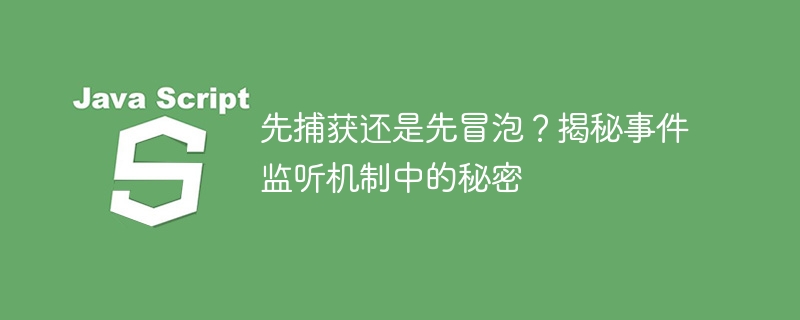Home >Web Front-end >JS Tutorial >Capture first or bubble first? Revealing the secrets of the event monitoring mechanism
Capture first or bubble first? Revealing the secrets of the event monitoring mechanism
- PHPzOriginal
- 2024-02-19 20:21:091079browse

Event listening mechanism is one of the very important concepts in modern programming. It allows developers to capture and process various events during program running in response to user input or system changes. However, when implementing an event listening mechanism, a common problem is choosing between capturing and bubbling. Should we capture the event first or bubble the event first? This is a question that developers often confuse, and this article will try to reveal the secrets.
First, let us understand what event capturing and event bubbling are. There is a DOM tree structure in the page, and events will propagate downward from the root node to the target element, and then propagate upward from the target element to the root node. When an event propagates from the root node to the target element, it is called the event capture phase; when the event propagates from the target element to the root node, it is called the event bubbling phase.
In early browsers, the event model mainly used the event bubbling mechanism. That is to say, the event will start from the target element and trigger related events of each ancestor element along the DOM tree from bottom to top. The advantage of this mechanism is that it is simple and easy to understand and implement. However, with the development of the Internet and web applications, pages are becoming more and more complex, and more and more events need to be processed. In this case, the event bubbling mechanism will bring some inconvenience.
In order to solve the problems caused by the event bubbling mechanism, W3C introduced the event capture mechanism in 1999. The event capture mechanism is opposite to the event bubbling mechanism. The event will start from the root node and propagate from top to bottom along the DOM tree to the target element. Compared with the event bubbling mechanism, the event capture mechanism is more flexible and has certain advantages when handling some complex events. For example, when we want to intercept and handle some other event before the user clicks on an element, we can use the event capture mechanism.
So, theoretically speaking, the event capture mechanism seems to be better than the event bubbling mechanism. But in actual development, choosing which mechanism to use is often a trade-off. In fact, in most cases, we don't need to make a clear choice between event capturing and event bubbling. This is because in modern browsers, the DOM event model uses a combination of event bubbling and event capturing.
Specifically, when an event is triggered, the browser will execute the event handler in the following order:
- Event capture phase: starting from the root node and propagating downward to the target element.
- Target phase: Execute the event handler on the target element.
- Event bubbling stage: starting from the target element and propagating upward to the root node.
Under this combination mechanism, developers can choose to execute event handlers in the capture and bubbling phases according to actual needs. For example, you can stop further propagation of an event by using the event.stopPropagation() method in an event handler, thereby choosing to end event processing in the capture phase or the bubbling phase.
In general, event capture and event bubbling in the event listening mechanism are complementary to each other, and there is no clear sequence. Choosing which mechanism to use depends on specific usage scenarios and development needs. In actual development, we should comprehensively consider the specific situation and use the combination mechanism provided by modern browsers to achieve flexible event processing.
In this increasingly complex technology era, it is very important to understand the secrets of event listening mechanisms. Only by mastering the correct processing method can we better provide users with a good interactive experience and implement excellent web applications. So, let us learn and explore together and continuously improve our technical capabilities!
The above is the detailed content of Capture first or bubble first? Revealing the secrets of the event monitoring mechanism. For more information, please follow other related articles on the PHP Chinese website!

